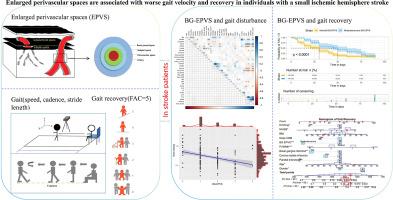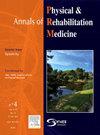Enlarged perivascular spaces are associated with worse gait velocity and recovery in individuals with a small ischemic hemisphere stroke: A cross-sectional study
IF 4.6
3区 医学
Q1 REHABILITATION
Annals of Physical and Rehabilitation Medicine
Pub Date : 2025-08-04
DOI:10.1016/j.rehab.2025.102005
引用次数: 0
Abstract
Background
Enlarged perivascular spaces (EPVS) are commonly observed in individuals with cerebral small vessel disease (CSVD) and have been associated with gait impairments in older adults and are also linked to post-stroke disability. Among individuals with mild stroke, persistent gait disturbance limitations often pose significant challenges to the resumption of daily activities. The relationship between EPVS and gait disturbance and gait recovery in individuals with mild stroke, remains poorly understood.
Objective
This study aimed to examine the hypothesis that EPVS are associated with gait disturbance and delayed gait recovery in individuals with mild stroke.
Methods
Between May and November 2023, 164 participants with small ischemic hemisphere strokes were enrolled within one week of stroke onset. EPVS were assessed using magnetic resonance imaging (MRI), while gait disturbance was measured by gait velocity, cadence, and stride length, with metrics extracted using the BlazePose architecture. Gait recovery was monitored by tracking the return to independent gait over time. Linear and logistic regression models were used to explore the relationship between EPVS and gait disturbance, while multifactorial Cox regression models were employed to assess the impact of EPVS on gait recovery.
Results
The mean [SD] age of the participants was 66.8 [9.7] years, with 72 % of the cohort being male. In multiple linear regression analyses, the presence of EPVS in the basal ganglia (BG-EPVS) was found to be a significant predictor of reduced gait velocity (β= -0.06; [95 % CI, -0.09 to -0.03]). In the multifactorial Cox regression model, moderate to severe BG-EPVS were significantly associated with delayed recovery of independent gait among participants with stroke, adjusted hazard ratio (aHR) 0.55 [95 % CI, 0.38 to 0.79].
Conclusion
The presence of BG-EPVS was found to be significantly associated with gait disturbance and delayed recovery of independent gait in individuals with mild stroke, indicating the potential role of EPVS as a predictor of gait recovery.

一项横断面研究表明,小局部缺血性脑卒中患者的步态速度和恢复能力与血管周围空间增大有关。
背景:血管周围间隙扩大(EPVS)常见于脑小血管疾病(CSVD)患者,并与老年人步态障碍有关,也与卒中后残疾有关。在轻度中风患者中,持续的步态障碍限制通常对恢复日常活动构成重大挑战。EPVS与轻度中风患者步态障碍和步态恢复之间的关系尚不清楚。目的:本研究旨在验证EPVS与轻度脑卒中患者步态障碍和步态恢复延迟相关的假说。方法:在2023年5月至11月期间,164名小缺血性半球卒中患者在卒中发作一周内入组。使用磁共振成像(MRI)评估EPVS,通过步态速度、节奏和步幅测量步态障碍,并使用BlazePose架构提取指标。随着时间的推移,通过跟踪独立步态的恢复来监测步态恢复。采用线性和逻辑回归模型探讨EPVS与步态障碍之间的关系,采用多因素Cox回归模型评估EPVS对步态恢复的影响。结果:参与者的平均[SD]年龄为66.8[9.7]岁,其中72%为男性。在多元线性回归分析中,发现基底神经节EPVS (BG-EPVS)的存在是步态速度降低的显著预测因子(β= -0.06;[95% CI, -0.09 ~ -0.03])。在多因素Cox回归模型中,中度至重度BG-EPVS与卒中患者独立步态恢复延迟显著相关,校正风险比(aHR)为0.55 [95% CI, 0.38 ~ 0.79]。结论:发现BG-EPVS的存在与轻度脑卒中患者步态障碍和独立步态延迟恢复显著相关,提示EPVS可能作为步态恢复的预测因子。
本文章由计算机程序翻译,如有差异,请以英文原文为准。
求助全文
约1分钟内获得全文
求助全文
来源期刊

Annals of Physical and Rehabilitation Medicine
Medicine-Rehabilitation
CiteScore
7.80
自引率
4.30%
发文量
136
审稿时长
34 days
期刊介绍:
Annals of Physical and Rehabilitation Medicine covers all areas of Rehabilitation and Physical Medicine; such as: methods of evaluation of motor, sensory, cognitive and visceral impairments; acute and chronic musculoskeletal disorders and pain; disabilities in adult and children ; processes of rehabilitation in orthopaedic, rhumatological, neurological, cardiovascular, pulmonary and urological diseases.
 求助内容:
求助内容: 应助结果提醒方式:
应助结果提醒方式:


